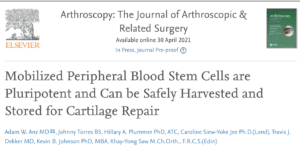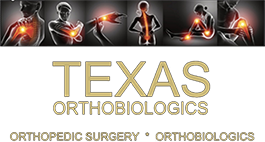I have been involved in recent discussions with patients and clinicians who were under the impression that there are stem cells in circulating blood and therefore also in platelet rich plasma. They have this impression from well known podcasts, from some doctor and chiropractic clinics, and in one case from a company still in the midst of a class action lawsuit whose business model was selling PRP as a stem cell treatment for severe pulmonary diseases (The Lung Institute)
The truth? There are no significant numbers of stem cells in circulating blood. Thumbs down to those still defrauding people with that claim.Umbilical cord blood and human blood are not sources of stem cells.
In 2021 in the USA, Clinicians wishing to treat patients with autologous stem cells need to source them from two main sources…bone marrow or adipose tissue. Unfortunately, there are clinicians who are either unwilling or unable to harvest autograft sources and yet still want to “treat” patients with “stem cell” injections.
For this reason, an entire orthobiologics sales pitch was built on marketing allograft birth product stem cells that could be overnighted to an office and then thawed out about 20-30 min before they were used for an orthopedic injection. This marketing claim came from companies and salespeople selling amniotic fluid, umbilical cord blood/tissue, Wharton’s Jelly, and other combo birth tissue products as off the shelf bottled stem cell injections.
False….Thumbs Down to companies and clinicians still making claims that shipped allograft birth tissue products have viable stem cells. Are Stem Cells in Amniotic Fluid?
BUT WAIT
What if there were a drug that mobilizes stem cells from the bone marrow into the peripheral circulation? We could give patients this drug that “pushes” stem cells in the peripheral circulation so that we could then just draw blood that would then actually have stem cells in it. This would eliminated the need to harvest bone marrow or adipose tissue. Does such a drug exist? Maybe. There is a drug used in cancer therapy called Filgrastim….also called Neupogen or Granix. The currently approved use is to help the body make more white blood cells. It is most commonly used for patients on chemotherapy, with chronic neutropenia, or with radiation exposure related diseases. Filgrastim has been noted to mobilize stem cells from the bone marrow space to enter the peripheral circulation….which led some forward thinking researchers to design a study to evaluate this effect to see if it might have a clinical application. I am interested because it would be amazing to not have to aspirate bone marrow for cellular therapy in orthobiologics.

In this paper just published in April, 2021, in the Journal of Arthroscopy & Related Research, we have some results from their study. The authors gave 10 patients 3 consecutive daily doses of Filgrastim and then did an apheresis harvest of mononuclear cells on the 4th day. All cell samples had a CFU assay to test proliferative potential. 5 samples were tested for differentiation potential. One interesting note is that they stored and tested these cells out to two years.
Results: On the “fresh” blood draw and apheresis there was an avg. cell count (TNCC) of 532 million total nucleated cells and 2.1 million CD34+ cells in 4cc. After processing for cryopreservation, the avg. TNCC was 331 million and 1.5 million CD34+ cells in 4cc. What about the CFU counts? The average reported CFU-f/cc count was 301.4
Discussion: The results raise several clinical issues.
#1 CFU Count of 301.4/cc Very, very low…maybe between 15-20 times lower than BMC results as compared to recently published bone marrow concentrate CFU numbers (Hernigou ’20 CFU/cc: 5727) (Buford ’21 CFU/cc: 4907) Especially for a technique 100% based on retrieving MSCs and not on harvesting any other biologically active agents…this method falls far short of autologous bone marrow concentrate on a per cc basis. In fact, the reported count of 301 CFU/cc is 65% lower than just the bone marrow aspiration results from our recently completed study (870 CFU/cc) …and we get all of the growth factors and cytokines and other biologically active elements with a bone marrow aspiration….elements that may be as important or more important than just the stem cell count. BTW, The TNCC counts were low too….
#2 Orthobiologic Plasma differences There is a significant difference between the growth factors, proteins, and cytokines in peripheral blood versus bone marrow. For example IRAP has been shown to be about 20x higher in bone marrow concentrate compared to even PRP. So clinically even if we made PRP to go along with this really low CFU/cc apheresis technique, we would be delivering a very different orthobiologic compared to BMC. BMC versus PRP
#3 Cost of Filgrastim According to GoodRX, the lowest price for this drug is about $315/dose. The 3 dose protocol in this study would cost $945 just for the medications.
#4 Potential Drug Side Effects The safety profile for Filgrastim has been researched. Here is a list of the most commonly reported side effects: bone pain, injection-site reaction, rash, acute neutrophilic dermatoses, allergic reaction, worsening of inflammatory conditions, and splenic enlargement. The most common adverse event associated with patients receiving filgrastim relative to patients receiving placebo appears to be bone pain. Filgrastim Safety Profile
Ultimately I think this idea of harvesting stem cells from the peripheral blood after drug application is a really interesting concept. We just need a drug that pushes way way more stem cells into the blood just to be able to enter the same CFU/cc count region as a bone marrow concentrate procedure.
Obviously this technique is making a very different orthobiologic compared to bone marrow concentrate whether or not PRP is added to the stem cell apheresis. The addition of a drug regimen over 3 days adds additional cost and potential side effects not present with an autologous bone marrow or even adipose technique. The clinical safety and efficacy of an in office bone marrow aspiration has been well established by multiple researchers over the years. In our office patients get a bone marrow aspiration done in about an hour and 16 minutes of that is just the centrifuging of the bone marrow! So it appears this Filgrastim stem cell mobilization technique is interesting but doesn’t yet provide any advantages over a simple in office bone marrow aspiration….maybe with further study and refinement and technical development we will have autologous MSC options that don’t require getting bone marrow or adipose tissue….just not yet.







Comments